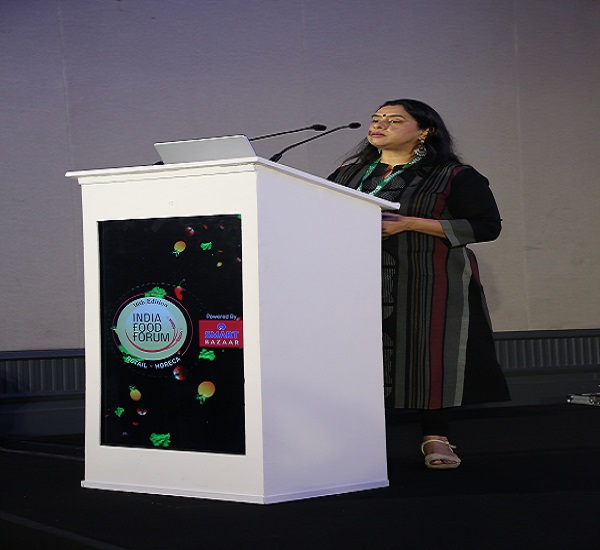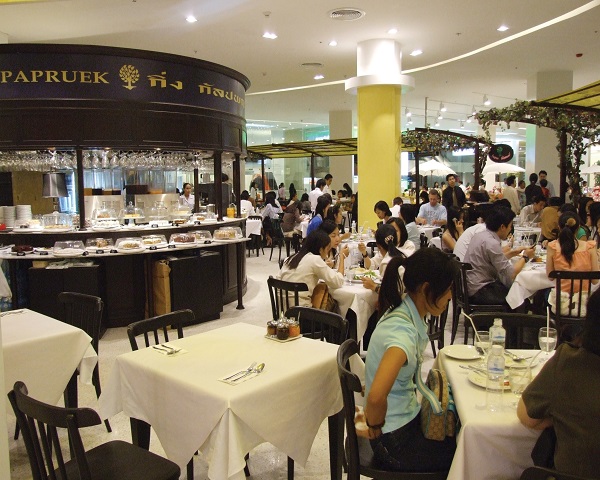India’s foodservices industry has made an impressive comeback post pandemic, surging to a substantial 558 billion USD. With the organized sector aiming for an 80% growth from its current 47% market share, segments such as casual dining and QSRs are playing a pivotal role in this expansion, unveiling a lucrative 33 billion USD opportunity.
The foodservices industry is also shaking things up to match evolving tastes with cool concepts like hybrid dining and cloud kitchens. When it comes to facing challenges like competition and higher costs – they’re tackling them head-on with a wave of high-tech automation across the board. Stay tuned for a blend of innovation and efficiency that’ll make your dining experience even more delicious.
Pakhi Saxena, Business Director, Retail CPG, Wazir Advisors, commenced her presentation sprinkled with foodservice insights that sought to unravel the underlying intricacies of India’s foodservices industry. Off her mark, she brought up some key numbers that paint a vivid picture of the industry’s trajectory.

Industry Overview and Growth
Before the pandemic struck, the Indian foodservices industry stood at a formidable 55 billion USD. “The pandemic, a challenge for all consumer-facing services, hit us hard, resulting in a significant 40% scale reduction. Fast forward two years, and thanks to the resilience and agility of our industry’s key stakeholders, we’ve not only bounced back but soared to a remarkable 558 billion USD market,” said Pakhi.
“What is captivating,” she added, is the resurgence of the organized sector, reclaiming its market share and currently holding a strong 47%. This share is poised to grow even further, reaching an impressive 53% in the next three years. “The 58 billion USD market being discussed is steadily growing at a robust CAGR of 12%, promising an 80 billion USD addressable market within their reach.”
Segmentation and Market Share
“Turning our attention to the impactful 47%, equivalent to nearly 35 billion USD, let’s delve into the factors propelling this market share. Diverse segments shape the organized play in India — ranging from casual dining restaurants, QSRs, cafes, pub bars, to club lounges,” said Pakhi noting that a fascinating development is the emergence of newer segments like cloud kitchens, conspicuously absent just a few years ago.
Currently, casual dining restaurants and quick service restaurants (QSRs) hold a significant 70% share in the 35 billion USD market. Poised for expansion, this share is on track to reach 80%, presenting a golden opportunity of approximately 33 billion USD in the next three years.
Segments such as cafes, pubs, lounges, cloud kitchens, and others, are expected to contribute a substantial 8 billion USD, presenting a significant opportunity. This financial influx will pave the way for the development of fresh business models, diverse formats, new cuisines, and innovative approaches to connect with consumers, enhancing consumer engagement and marketing. All of these factors are set to boost and fuel the growth of the organized sector.
Unorganized Sector Dynamics
Besides the big multinational companies that have been using strategies like creating new products and buying other companies, there are also smaller independent restaurants, also known as single chain restaurants. These restaurants play a big role in the whole foodservices scene. “The exciting part is that this entire industry comprising independent restaurants is expected to become a huge 32 billion USD market in the next three years, noted Pakhi.
These smaller restaurants are also gearing up for action. They are planning to introduce more local foods and flavors, aiming to encourage smaller, unorganized food businesses to become organized. This shift is expected to bring about new and interesting combinations of foods, flavors, and ingredients. In simple terms, all of these developments are creating more opportunities and making them even more significant.
Key Drivers of Industry Growth
The important growth drivers are that first, people are dining out more frequently compared to earlier times. Although the dine-out frequency dropped drastically during the pandemic, the trend has bounced back and is on the rise.
Another noteworthy aspect is the increasing demand for diverse food options and flavors. In the current scenario, Indians are exploring new and exciting culinary experiences while continuing to relish their traditional favorites. “The collective impact of these factors is widening the array of choices for those who dine out, prompting both local and international restaurants to expand their presence and enhance their menus to appeal to customers,” remarked Pakhi.
Additionally, the improved availability of retail space has facilitated the emergence of niche formats and distinct offerings, while higher smartphone and internet penetration have expanded the total addressable market. Think about how many people have smartphones in their hands – a lot, right? Well, because of that, more people can easily order food using their phones. Plus, there’s this cool thing called UPI payments that make it super easy to pay. All these digital tools are like helpers, making the food business grow even more.
Changing Formats and Innovations
Due to busy lives, there’s a trend where people don’t always have time to sit down and eat at a restaurant. That’s why takeaways and home deliveries have become really popular. On the other side of things, there’s more space for shops and restaurants to set up. This means there are new and special kinds of places to get food. It’s like having more options to choose from.
At the same time, “there are some new kinds of places popping up that are a mix of different styles – they’re called hybrid formats. Brands are getting creative and trying different ways to attract people based on how they like to eat and spend their day,” said Pakhi.
Now, when it comes to getting your food delivered, it’s not just the big companies like Swiggy and Zomato doing it. Each restaurant wants to have a special connection with its customers, so many of them have their own delivery systems.
Next up, there is the emergence of cloud kitchens, which are like super-efficient kitchens that can make food without needing a big fancy restaurant. This setup is beneficial for younger individuals and working professionals, and it’s also contributing to offering healthier food options. “The surge in cloud kitchens,” said Pakhi, “is due to low initial investments and high-profit margins.”
Some packaged food brands and foodservice players are focusing on making really healthy food, like salads or gluten-free meals. They even have these kits that let you make their special dishes at home. Chefs are also using cool technology to make amazing new dishes, almost like magic in the kitchen. “Even International brands in India are learning what we like and changing their food a bit to match our taste. That’s cool, right? Finally, there’s a trend where it’s not just about the food – it’s also about the whole experience. People want to enjoy their meals not just at a restaurant but also in the comfort of their homes. So, it’s not just about what you eat, it’s about how you enjoy it!,” observed Pakhi.
Focus on Overall Experience
Fresh retail concepts are making eating out a really enjoyable and unique experience. These concepts introduce what is known as experiential dining, where the meal isn’t just about eating but also about having a special time.
Imagine stepping into these hip retail spots that turn every meal into a fantastic and one-of-a-kind experience. They’re like food wonderlands introducing what we call “experiential dining.” It’s not just about munching down delicious bites; it’s about creating memorable moments with your meal
“On one side, there are pop-up restaurants and kiosks. These are like temporary places that appear for a short time. Even the really fancy and special dining spots are joining in. It’s like they’re bringing their tasty food closer to people so they can try it out and see if they like it,” said Pakhi.
Challenges and Opportunities
Challenges for foodservice players include competition with packaged food companies, rising raw material costs, seasonal shortages, and supply chain inefficiencies. The companies making packaged food are coming up with some super cool new ideas! They’re getting really creative and making lots of different and tasty things for us to eat. Imagine having ready-to-eat meals or stuff that you can easily cook yourself – they’ve got it all covered! These companies are like food wizards, bringing us all sorts of yummy options and competing to see who can offer the best ready-to-eat and ready-to-cook meals in different flavors and cuisines.
“Now, let’s talk about something important – the cost of making food. You see, the price of the ingredients that go into making our meals is going up. This happens because sometimes certain ingredients are not available all year round, and that can make things a bit tricky. So, when the cost of these raw materials goes up, it becomes a challenge for the food industry to manage their expenses and make sure they can still provide tasty food without making it too expensive for us. It’s like a puzzle they need to solve to keep things balanced and affordable,” observed Pakhi.
One of the major challenges in the foodservices industry relates to supply chain efficiencies. The businesses often face difficulties in getting the right products from suppliers that match their desired specifications. This is crucial for them to create the perfect dishes they want to offer to their customers. When there are issues in the supply chain, it can lead to more wastage, affecting the quality of the food.
When it comes to opportunities, one key aspect is the automation of business operations. Major players in the food services industry are using automation to make their operations smoother, provide better service, connect with consumers, and engage them more effectively. This includes optimizing menu services, especially in Quick Service Restaurants (QSRs), which make up 70% of the organized pie and a significant 33 billion USD.
“There is a noticeable emphasis on agility and efficiency in operations, learning from successful practices. Businesses are exploring ways to combine agility and lean operations for better results. Additionally, there’s a push for innovative marketing campaigns. Even though the industry didn’t focus much on engaging with consumers in the past, it’s evolving now, and with the entire market growing, there are newer and diverse ways to connect with consumers. Innovative messaging, outreach, and other opportunities are waiting to be explored and utilized,” concluded Pakhi.




